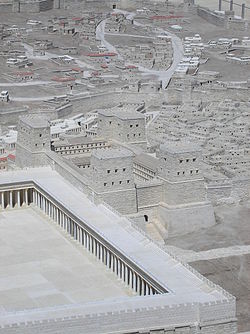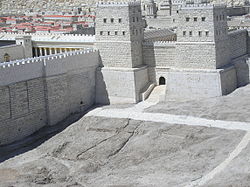Antonia Fortress: Difference between revisions
→Description: sourcing |
Added alternative theory that several, other scholars believe; a longer version was deleted with the edit summary, “shorten to two sentences”, |
||
| Line 27: | Line 27: | ||
Josephus attests to the importance of the Antonia: "For if the Temple lay as a fortress over the city, Antonia dominated the Temple & the occupants of that post were the guards of all three." Josephus placed the Antonia at the northwest corner of the colonnades surrounding the Temple. Modern depictions often show the Antonia as being located along the north side of the temple enclosure.{{cn|date=June 2020}} |
Josephus attests to the importance of the Antonia: "For if the Temple lay as a fortress over the city, Antonia dominated the Temple & the occupants of that post were the guards of all three." Josephus placed the Antonia at the northwest corner of the colonnades surrounding the Temple. Modern depictions often show the Antonia as being located along the north side of the temple enclosure.{{cn|date=June 2020}} |
||
==Alternative theory== |
|||
[[Ernest L. Martin]] asserts a controversial claim in his book, ''The Temples that Jerusalem Forgot'',<ref>Ernest L. Martin, The Temples that Jerusalem Forgot, Paperback: 485 pages by Academy for Scriptural (February 1994) in English. ISBN 0-945657-95-1 and ISBN 978-0-945657-95-8</ref> that the [[City of David|Ophel Mound]] is the site of the First and Second Temples and what is called the Temple Mount today was in fact the Roman Fort Antonia. |
|||
However, after studying the words of Josephus concerning the [[Herod's Temple|Temple of Herod the Great]], which was reported to be in the same general area of the former Temples, he then read the account of Eleazar who led the final contingent of Jewish resistance to the [[Roman Empire|Romans]] at [[Masada]] which stated that the Roman fortress was the only structure left by 73 CE "''With this key in mind, I came to the conclusion in 1997 that all the Temples were indeed located on the Ophel mound over the area of the [[Gihon Spring]]''".<ref>Martin, Ernest L. '"The Temples that Jerusalem Forgot.''"(2000). p.iv ISBN 0-945657-95-1</ref> |
|||
==See also== |
==See also== |
||
Revision as of 03:10, 9 September 2020


The Antonia Fortress (Aramaic:קצטרא דאנטוניה)[a] was a citadel built by Herod the Great and named for Herod's patron Mark Antony, as a fortress whose chief function was to protect the Second Temple. It was built in Jerusalem at the eastern end of the so-called Second Wall, at the north-western corner[1][2] of the Temple Mount.
History
Herod (r. 37 – c. 4 BCE) built the fortress to protect the Temple. He named it for his patron Mark Antony (83–30 BCE).[3] The fortress housed some part of the Roman garrison of Jerusalem. The Romans also stored the high priest's vestments within the fortress.[citation needed]
The fortress was one of the last strongholds of the Jews in the Siege of Jerusalem (70 CE), when the Second Temple was destroyed.[3]
Construction date controversy
The construction date is controversial because the name suggests that Herod built Antonia before the defeat of Mark Antony by Octavian in 31-30 BCE and Mark Antony's suicide in 30 BCE. Herod is famous for being an apt diplomat and pragmatist, who always aligned himself with the winning side and the "man in charge" of Rome. It is somewhat difficult to bring this date in accordance with the presumed date for the construction of the Herodian Temple.
Christian tradition
Traditionally, Christians have believed for centuries that the vicinity of the Antonia Fortress was the site of Pontius Pilate' praetorium, where Jesus was tried for high treason. This was based on the assumption that an area of Roman flagstones discovered beneath the Church of the Condemnation and the Convent of the Sisters of Zion was 'the pavement' which John 19:13 describes as the location of Jesus' trial. Archaeological investigation indicates that about a century after the presumed time of Jesus' death, this site became that of the eastern of two forums built by Hadrian in around 130 CE as part of his new city, the Aelia Capitolina,[4][5] but it is possible that following the Antonia Fortress's destruction its pavement tiles were brought to Hadrian's plaza.[6] The eastern forum of the Aelia Capitolina was built over the Struthion Pool, which was mentioned by first-century historian Josephus as being adjacent to the fortress (Josephus, Jewish War 5:11:4).[citation needed]
Like Philo, Josephus testifies that the Roman governors stayed in Herod's Palace while they were in Jerusalem,[7] and carried out their judgements on the pavement immediately outside it (Josephus, Jewish Wars, 2:14:8). Josephus indicates that Herod's Palace is on the Western Hill (Jewish Wars, 5:2) and in 2001 some of its vestiges were rediscovered under a corner of the Tower of David.[8] Archaeologists therefore conclude that in the first century, the praetorium—the residence of the praefectus (governor)—was on the Western Hill, rather than at the Antonia Fortress, on the opposite side of the city.[4][5] As the tradition retained its power and as a result of its association with Jesus' trial, the site of the fortress serves as the starting point of the Via Dolorosa commemorating the crucifixion of Jesus.
Description
Although modern reconstructions often depict the fortress as having a tower at each of four corners, Josephus repeatedly refers to it as "the tower Antonia", and states that it had been built by John Hyrcanus and later by King Herod, and used for a vestry, in which were reposited the vestments of the high priest.[9] Josephus states:
The general appearance of the whole was that of a tower with other towers at each of the four corners; three of these turrets were fifty cubits high, while that at the south-east angle rose to seventy cubits and so commanded a view of the whole area of the temple.[10]
Some archaeologists are also of the opinion that the fortress was only a single tower, located at the south-east corner of the site.[11] For example, Pierre Benoit, former professor of New Testament studies at the École Biblique, having carried out extensive archaeological studies of the site,[5] states that there is absolutely no (archaeological) support for there having been four towers.[4]
Josephus attests to the importance of the Antonia: "For if the Temple lay as a fortress over the city, Antonia dominated the Temple & the occupants of that post were the guards of all three." Josephus placed the Antonia at the northwest corner of the colonnades surrounding the Temple. Modern depictions often show the Antonia as being located along the north side of the temple enclosure.[citation needed]
Alternative theory
Ernest L. Martin asserts a controversial claim in his book, The Temples that Jerusalem Forgot,[12] that the Ophel Mound is the site of the First and Second Temples and what is called the Temple Mount today was in fact the Roman Fort Antonia.
However, after studying the words of Josephus concerning the Temple of Herod the Great, which was reported to be in the same general area of the former Temples, he then read the account of Eleazar who led the final contingent of Jewish resistance to the Romans at Masada which stated that the Roman fortress was the only structure left by 73 CE "With this key in mind, I came to the conclusion in 1997 that all the Temples were indeed located on the Ophel mound over the area of the Gihon Spring".[13]
See also
References
Footnotes
- ^ Based on Josephus' use of the word 'citadel' or 'fortress' when referring to the Antonia Fortress
Citations
- ^ "Antonia Fortress". Madain Project. Archived from the original on 29 May 2020. Retrieved 29 May 2020.
- ^ "Antonia Fortress According to Josephus". Madain Project. Archived from the original on 29 May 2020. Retrieved 29 May 2020.
- ^ a b Jerusalem, Israel, Petra & Sinai. DK. 2016 [2000]. p. 48. ISBN 978-1-4654-4131-7.
- ^ a b c Benoit, Pierre, The Archaeological Reconstruction of the Antonia Fortress, in Jerusalem Revealed (edited by Yigael Yadin), (1976)
- ^ a b c Benoit, Pierre (1971). "L'Antonia D'Hérode le Grand et le Forum Oriental D'Aelia Capitolina". Harvard Theological Review. 64 (2–3). Cambridge, U.K.: Cambridge University Press: 135–167. ISSN 0017-8160.
- ^ "Ecce Homo Arch Video". Jerusalem Experience. 2012.
- ^ Pierre Benoit, The Archaeological Reconstruction of the Antonia Fortress, p. 87, in Jerusalem Revealed (edited by Yigael Yadin), (1976)
- ^ Jacqueline Schaalje, "Israeli Archaeologists Discover Herod's Palace", The Jewish Magazine (October 2001).
- ^ Josephus, Antiquities of the Jews 18:4:3; 15.403
- ^ Josephus, The Jewish War, Book V, v. 238, pp. 275 & 277, translated by Henry St. John Thackeray, The Loeb Classical Library, William Heinemann Ltd (London) and Harvard University Press, 1961 (reprint of 1928 first edition). Accessed July 2020.
- ^ Pierre Benoit, "The Archaeological Reconstruction of the Antonia Fortress", p. 89, in Jerusalem Revealed (edited by Yigael Yadin), (1976)
- ^ Ernest L. Martin, The Temples that Jerusalem Forgot, Paperback: 485 pages by Academy for Scriptural (February 1994) in English. ISBN 0-945657-95-1 and ISBN 978-0-945657-95-8
- ^ Martin, Ernest L. '"The Temples that Jerusalem Forgot."(2000). p.iv ISBN 0-945657-95-1
External links
 This article incorporates text from a publication now in the public domain: Lieut.-Col. Claude R. Conder (1901–1906). "Antonia". In Singer, Isidore; et al. (eds.). The Jewish Encyclopedia. New York: Funk & Wagnalls.
This article incorporates text from a publication now in the public domain: Lieut.-Col. Claude R. Conder (1901–1906). "Antonia". In Singer, Isidore; et al. (eds.). The Jewish Encyclopedia. New York: Funk & Wagnalls.
- 19 BC
- Buildings and structures completed in the 1st century BC
- 1st-century BC establishments in Judea
- Jews and Judaism in the Roman Empire
- Ancient sites in Jerusalem
- Archaeological sites in Israel
- Architectural history
- Former buildings and structures in Israel
- Forts in Israel
- Herod the Great
- Ancient history of Jerusalem
- Temple Mount
- 1st-century BC fortifications
- Pontius Pilate
